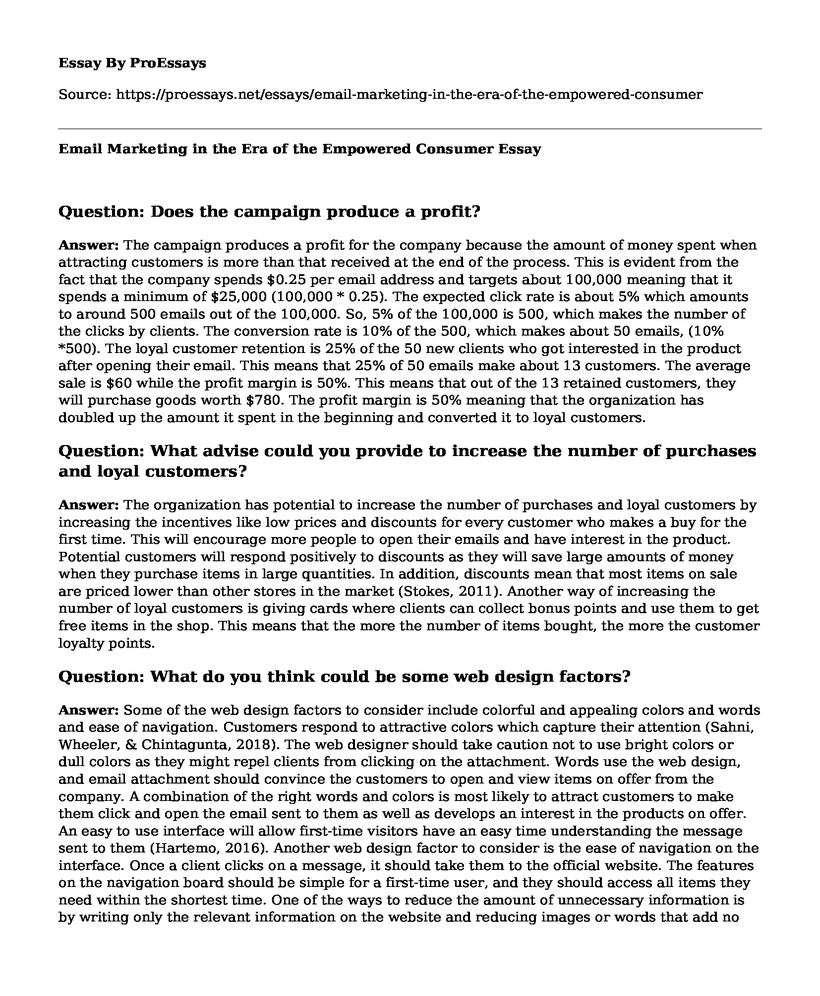Question: Does the campaign produce a profit?
Answer: The campaign produces a profit for the company because the amount of money spent when attracting customers is more than that received at the end of the process. This is evident from the fact that the company spends $0.25 per email address and targets about 100,000 meaning that it spends a minimum of $25,000 (100,000 * 0.25). The expected click rate is about 5% which amounts to around 500 emails out of the 100,000. So, 5% of the 100,000 is 500, which makes the number of the clicks by clients. The conversion rate is 10% of the 500, which makes about 50 emails, (10% *500). The loyal customer retention is 25% of the 50 new clients who got interested in the product after opening their email. This means that 25% of 50 emails make about 13 customers. The average sale is $60 while the profit margin is 50%. This means that out of the 13 retained customers, they will purchase goods worth $780. The profit margin is 50% meaning that the organization has doubled up the amount it spent in the beginning and converted it to loyal customers.
Question: What advise could you provide to increase the number of purchases and loyal customers?
Answer: The organization has potential to increase the number of purchases and loyal customers by increasing the incentives like low prices and discounts for every customer who makes a buy for the first time. This will encourage more people to open their emails and have interest in the product. Potential customers will respond positively to discounts as they will save large amounts of money when they purchase items in large quantities. In addition, discounts mean that most items on sale are priced lower than other stores in the market (Stokes, 2011). Another way of increasing the number of loyal customers is giving cards where clients can collect bonus points and use them to get free items in the shop. This means that the more the number of items bought, the more the customer loyalty points.
Question: What do you think could be some web design factors?
Answer: Some of the web design factors to consider include colorful and appealing colors and words and ease of navigation. Customers respond to attractive colors which capture their attention (Sahni, Wheeler, & Chintagunta, 2018). The web designer should take caution not to use bright colors or dull colors as they might repel clients from clicking on the attachment. Words use the web design, and email attachment should convince the customers to open and view items on offer from the company. A combination of the right words and colors is most likely to attract customers to make them click and open the email sent to them as well as develops an interest in the products on offer. An easy to use interface will allow first-time visitors have an easy time understanding the message sent to them (Hartemo, 2016). Another web design factor to consider is the ease of navigation on the interface. Once a client clicks on a message, it should take them to the official website. The features on the navigation board should be simple for a first-time user, and they should access all items they need within the shortest time. One of the ways to reduce the amount of unnecessary information is by writing only the relevant information on the website and reducing images or words that add no value to the website.
Question: What communication messages would be most effective?
Answer: Some of the communication messages that would be most effective include the assurance of quality and value of products (Stokes, 2011). Customers would be willing and able to part with amounts of money which equate to the value of the item they will get in return. Hence, the online campaign should assure potential customers that products and services they purchase are of high value and that nothing will interfere with the quality and quantity.
References
Hartemo, M. (2016). Email marketing in the era of the empowered consumer. Journal of Research in Interactive Marketing, 10(3), 212-230.
Sahni, N. S., Wheeler, S. C., & Chintagunta, P. (2018). Personalization in Email Marketing: The Role of Noninformative Advertising Content. Marketing Science.
Stokes, R. (2011). eMarketing: The essential guide to digital marketing. Quirk eMarketing.
Cite this page
Email Marketing in the Era of the Empowered Consumer. (2022, Mar 29). Retrieved from https://proessays.net/essays/email-marketing-in-the-era-of-the-empowered-consumer
If you are the original author of this essay and no longer wish to have it published on the ProEssays website, please click below to request its removal:
- Essay Sample on Programming
- Demand and Supply of Cocoa: A Critical Analysis Essay
- Essay Sample on Social Media Public Relations Campaign: Starbucks Company
- Essay on Amazon.com Outshines Global Retail Market: Safe, Secure, & Professional Shopping
- Essay Sample on Cybersecurity Attacks and Defense Modeling
- Optima Health: Progressive & Flexible Health Care Services - Essay Sample
- Essay Example on Logistics: Optimizing Supply Chain to Compete in Global Market







